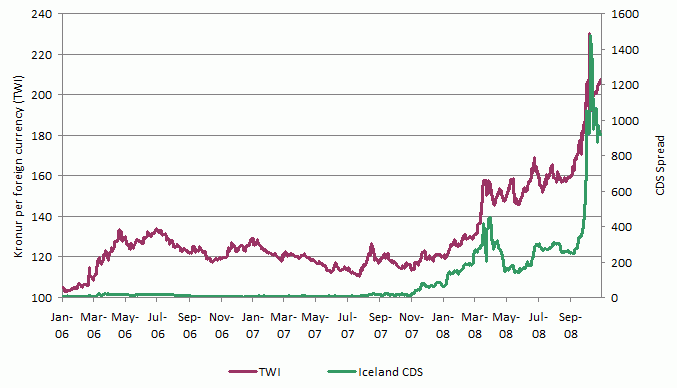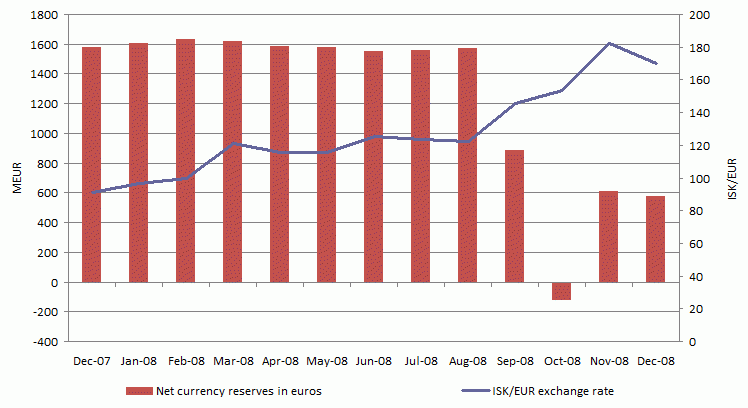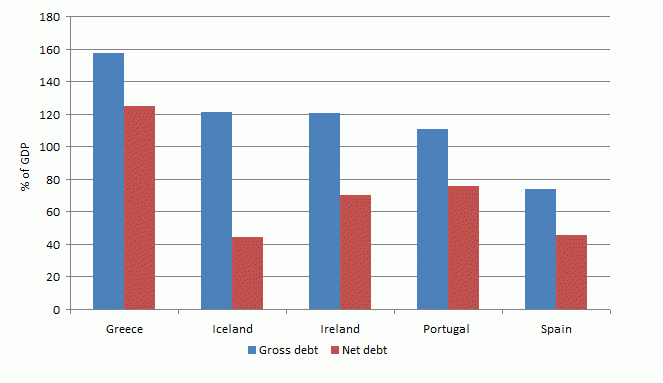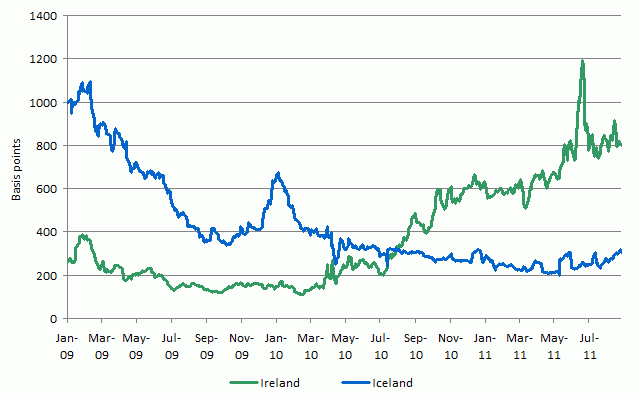When Iceland’s three main banks collapsed on 7–9 October 2008 it became obvious that Iceland would suffer a balance-of-payments crisis unless it could get outside support. A currency crisis was already under way (Figure 1). After some initial doubts it became clear to the government that it had no other option than to seek help from the IMF. The fund would not only provide financing and expertise, but also some much-needed credibility.
Figure 1. Trade-weightedexchange rate of the krona and Iceland’s CDS spread
Source: Central Bank of Iceland
An agreement with the IMF was reached on 24 October 2008 (IMF 2008). Against the assurance of following the policies of the programme, the IMF and friendly nations lent Iceland $5 billion – 40% of GDP – to serve its external financing needs over the next three years. The programme was completed on 26 August 2011.
Heterodox policies
Some of the policies implemented in Iceland as part of the IMF programme have been called heterodox (eg Krugman 2011). The imposition of capital controls in particular has been so characterised as well as the ‘repudiation of debt’, that is, letting institutional creditors of the banks bear the costs of their collapse rather than Icelandic taxpayers. There were, however, substantial costs. The net direct fiscal cost of the crisis amounts to approximately 20% of GDP and comes second only to that of Ireland within the OECD – at the latest reckoning.
It would have been highly risky not to impose capital controls. Firms’ debt was largely in foreign currency and households also had a significant amount of such debt. The remainder of lending was to a large extent indexed to the consumer price index which is highly sensitive to exchange-rate movements. As the carry-trade inflows which had supported the krona until the end of 2007 were first halted and then reversed, the exchange rate depreciated by 40% over the first three quarters of 2008. By October inflation was approaching 20% and inflation and exchange rate–linked debt shot up. Balance sheets of most firms and many households were already in tatters. But it was still crucially important to stabilise the exchange rate in order to prevent even more damage.
Currency reserves had been depleted to the extent that by the end of October 2008 they did not suffice to cover known outflows over the next twelve months let alone the huge stock of carry-trade money still left in Iceland (Figure 2). The 18% policy rate would perhaps have sufficed to slow down outflows and stabilise the exchange rate under other circumstances, but as things were it is questionable whether any interest rate would have stopped capital flight and a complete collapse of the krona in the absence of capital controls.
Figure 2. Iceland’s net currency reserves and exchange rate
Note: Net currency reserves are gross reserves less known outflows over the next 12 months. Source: Central Bank of Iceland
The capital controls have worked in the sense that since they were rigorously enforced the exchange rate has been stable and inflation has come down. Policy on lifting the controls has, however, been indecisive. A key prerequisite for lifting the controls was met in June 2011 when Iceland regained access to international capital markets and issued a $1 billion bond. It is both desirable and possible to begin opening up to capital movements in the near future.
A few hours before the first bank collapsed on 7 October, the Icelandic Parliament passed what has become known as the ‘emergency legislation’. This law gave deposits and deposit insurance priority over other claims on the banks and gave the Icelandic FSA the authority to ring-fence the domestic part of distressed banks by transferring domestic assets and liabilities into new banks. When each bank fell, its deposits in Icelandic branches were transferred into a newly created bank. Deposits in foreign branches were given priority status as claims on the old bank. Bondholders of the banks – mostly foreign parties, but also Icelandic pension funds and the Central Bank of Iceland – were left with claims to assets remaining in the old banks, second in line after deposits and deposit insurance. This was the ‘repudiation of debt’.
The emergency legislation was imposed independently of the IMF. But it was extremely important that the subsequent IMF programme implicitly supported this legislation.
From a banking and economic perspective the old-bank/new-bank split that was executed in Iceland was questionable (see eg Danielsson 2011a). It would surely have been better from that point of view to do a bad-bank/good-bank split, as in Sweden in the early 1990s. There were, however, good legal grounds for the choice that was made. The emergency legislation changed the priority order of claims retroactively, placing deposits ahead of bonds. It requires a strong legal argument not to find such an action to violate property-rights provisions of Iceland’s constitution.
On 28 October 2011 – more than three years after the crisis – Iceland’s Supreme Court confirmed the constitutionality of the legislation. The EFTA Surveillance Authority had opined earlier that the split did not violate EEA law. The basis for both those findings is that no available remedies other than those applied could have prevented the complete collapse of the Icelandic economy. It would have been much more difficult to argue that a bad-bank/good-bank split was imperative. Moving all the good loans to new banks along with domestic deposits, and leaving bad loans in the old would therefore hardly have passed legal muster. The first-best was not an available option in this case.
Many are familiar with the Icesave dispute which can also be placed in the ‘repudiation of debt’ category and has ignited high emotions inside and outside Iceland. Recovery from the Landsbanki estate is now predicted to be much better than originally estimated. All priority claims are set to be covered and the quarrel seems likely to fade away. (The Icesave issue has been discussed in several Vox columns, including two by this author. See Baldursson 2011 and 2010 and Sibert 2010.)
Fiscal consolidation
In October 2008 the IMF estimated the gross fiscal cost of the crisis to be 80% of GDP – over half of that due to foreign deposit insurance. There was pessimism about asset recovery so net costs were projected to be similar to gross costs. Still, it was decided to postpone spending cuts for one year. This was a wise decision. In the winter of 2008–09, as private demand collapsed and unemployment shot up to levels not seen since the Great Depression, the support given to aggregate demand by public spending was very important.
The progressive fiscal tightening of 2-3% of GDP annually in the three following years has of course been painful, but it was unavoidable. One can argue whether the mix between the raising of taxes and spending cuts has been right. And it is regrettable how little has been done on structural policies. But, on the whole, this is the most successful part of the programme. There is still a small primary deficit, but this is to be reversed in 2012. Net public debt is now a manageable 44% of GDP (Figure 3).
Figure 3. General government debt (% of GDP)
Source: OECD
That gross public debt is still excessively high in Iceland is mostly due to the large currency reserves financed by external loans, and equity stakes in the new banks financed by domestic borrowing. This situation can and should be unwound in coming years in order to lower gross debt to a sustainable level.
Banking policy
It was clear from the outset that an efficient insolvency regime would be needed for Iceland in order to manage widespread insolvency among firms as well as households after the crisis and to quickly place the new banks on a sound footing – to make them good banks. Progress on this front has been slow. This has been a costly failure. The rate of progress on the debt workout of firms has been excruciating – delinquent loans are 30% of the loan book of the banks. It took more than two years to change the law on personal insolvency such that households deeply in debt can be provided a fresh start in a similar way as under the US regime, and the execution has advanced very slowly. The consequence – and to some degree the cause – of this has been that the government has to an extent given in to demands for across-the-board debt reduction – a costly, ineffectual, and regressive policy (there is a strong positive correlation between debt, assets, and income).
Conclusion
Danielsson (2011b) has argued that Iceland’s IMF programme has been unsuccessful. I beg to differ. The programme was of course not perfectly designed. And implementation and execution could have been more decisive, especially as regards banking restructuring and the lifting of capital controls. But one need not look far to conclude that on this score performance was as good as or better than what can realistically be expected.
Iceland’s situation has gradually been normalised over the three years of the IMF programme (Figure 4). It is by no means an ideal situation yet. Unemployment is still high, growth is anaemic, and inflation too high (IMF 2011). But a turning point has been reached where better times can be seen ahead. And Iceland re-entered capital markets less than three years after the biggest banking crisis any country has suffered. It must be concluded that considerable success has been attained since the crisis. There are two key policies behind that success: the Icelandic emergency legislation, and Iceland’s programme with the IMF.
Figure 4. CDS spreads for Iceland and Ireland
Disclosure: In early October 2008 the author was recruited by the Icelandic Prime Minister‘s Office to lead negotiations with the IMF on Iceland‘s behalf. He worked in that capacity until 24 October 2008 when an agreement with the IMF was reached.
References
Baldursson, Friðrik (2011), “Icesave: Groundhog Day?”, VoxEU.org, 10 January.
Baldursson, Friðrik (2010), “Icesave: The big ultimatum”, VoxEU.org, 29 January.
Danielsson, Jon (2011a), “How not to resolve a banking crisis: Learning from Iceland’s mistakes”, VoxEU.org, 26 October.
Danielsson, Jon (2011b). “Was the IMF programme in Iceland successful?”, VoxEU.org, 27 October.
IMF (2008). “Iceland: Request for Stand-By Arrangement”, 25 November.
IMF (2011), “IMF Completes Sixth and Final Review Under the Stand-By Arrangement for Iceland”, 26 August.
Krugman, Paul (2011). “Iceland exits”, NYTimes.com, 1 September.
Sibert, Anne (2010), “The Icesave dispute”, VoxEU.org, 13 February.






